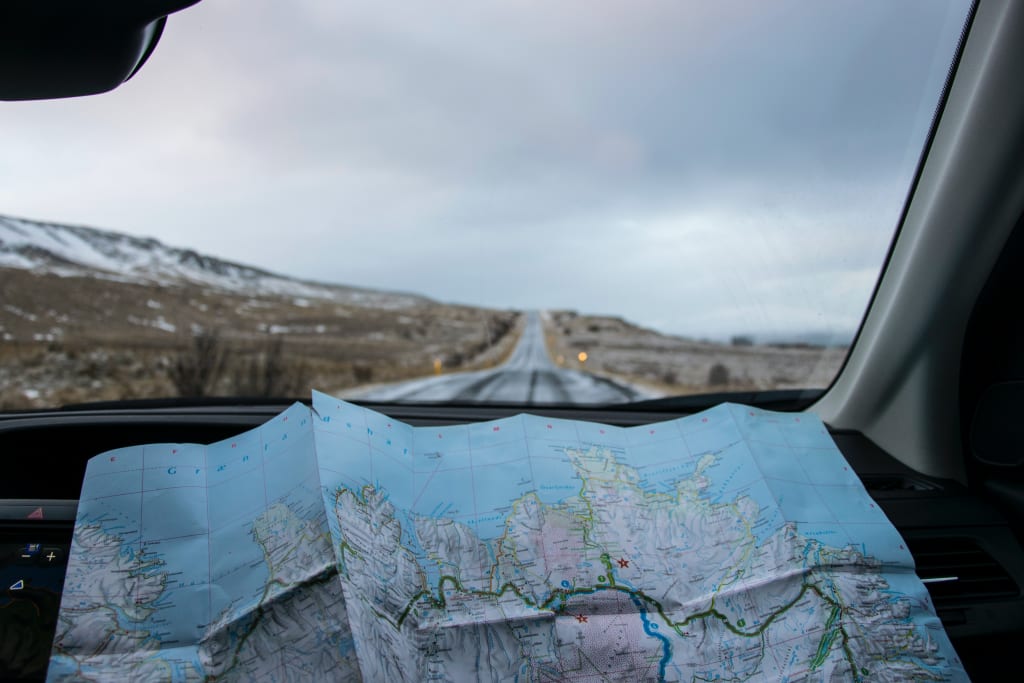It's Time to Update Your Mental Maps
How Your Map of the World is Leading You Astray

"The first rule of life: Be here now."
- Laurence Gonzales
What do you do when Instagram isn’t loading properly, or your Amazon app won’t open? ‘My internet is on and Safari is just fine. Maybe it needs to be updated.’ Your thumbs mosey on over to the app store and low-and-behold, it needs to be updated. We fixed some pesky bugs and made some improvements so the app works more smoothly. *UPDATE*.
What do you do when life doesn't appear to be “loading” properly? What about when life unapologetically drops a bomb on your plans?
Now Updating: Life
I first encountered the concept of Mental Maps at the age of 15 when I picked up a book that absolutely changed my life. This book is Deep Survival: Who Lives, Who Dies, and Why by Laurnce Gonzales. Laurence uses mental maps in terms of geographical location, which is by definition the standard use for this model.
Mental maps are the surrounding environment in the form of synaptic connections. Our brains acquire information about our environment and create a model for us to reference and relate to. For example, you can likely visualize your route to and from school where you grew up, or your current route to your local coffee shop. Our brains map this out for us so we can operate at a certain level of automaticity, leaving energy for various other cognitive functions. Your brain is like water in a way - it’s going to seek out the path of least resistance.
Now imagine you’re on the way to pick up your morning coffee, making the same old turns, going the same old speed, remembering that obnoxious speed bump that’s difficult to see. All of the sudden, your route is halted because of an accident up ahead. ‘Uhhh I guess I’ll turn here then.’ Now what?
Even if you’re traversing a grid-like area where a diversion isn’t entirely complicated, there is a moment of pause. Your map is still intact but your environment has changed. Google Maps comes in handy here, and I’m assuming most of us whip out our phones as soon as the path appears obstructed.
There's no Google Maps for life, though.
A Bent Map
As I wrote this article (in a coffee shop, of course) one of my friends came in for his shift. I asked how he was and he responded “Bad” with a nervous chuckle. The honesty was appreciated, as most of us tend to just pretend everything is okay. He went on to say he was concerned for his shop and that our situation (coronavirus, economic downturn, etc.) would be continuing for another year at the very least.
My friend was applying an old mental map to an updated landscape. The map he had prior to this pandemic and economic decline was now out of date. Even though he was in a familiar place amongst familiar people, he was still lost - trying to bend his map to fit, navigating by the stars on a cold overcast night.
He was lost, like most of us at the moment. Like all of us at some point in life. Being lost is a scary feeling, whether you’re 8 or 88.
Applying Mental Maps to Our Lives
Laurence talks about “bending the map” in his book, and how detrimental this practice can be. It’s like trying to add a curve to a sheet of glass. Would you want to go on a hike in an unfamiliar area armed with a map from 1987? Doubt it. The trail has likely changed due to the environment. Perhaps a heavy rain created another channel for the river to flow, wiping out a portion of the old trail. Maps are not meant to be bent. They’re meant to be updated.
He also discusses the idea of being lost in the eyes of a young child (ages 6 and under). At this age they pay attention to their instincts. They pay attention to what their body is telling them. They are unconsciously updating their mental maps to match their situation.
"In the beginner's mind there are many possibilities. In the expert's mind, there are few."
-Shunryu Suzuki
This is how we navigate an ever-changing world - with a beginner’s mind.
This Wasn’t Part of the Plan!
Think about a time in your life you were incredibly frustrated, sad, or hurt. Your partner cheated on you, you lost your job unexpectedly, a family member dies without warning. ‘How could this happen? This isn’t fair! There was so much more I wanted to do with my grandfather. This wasn’t part of the plan.’
"Plan the flight and fly the plan. But don’t fall in love with the plan. Be open to a changing world and let go of the plan when necessary so that you can make a new plan. Then, as the world and the plan both go through their book of changes, you will always be ready to do the next right thing."
-Laurence Gonzales
Our plans consist mostly of outdated mental maps - rolled up parchment paper from the 1800’s depicting uncharted western territories. Plans aren’t all bad, though. They can help us set goals and deadlines, but they cannot be unflinchingly rigid. As new information comes, add it to the map. ‘Oh my, a pandemic is leaving a trail of death, economic struggle, job loss, and countless obstructions to everyday life.’ That wasn’t part of the plan.
Update your system. Map it out. Move forward.
What Does an Updated Mental Map Look Like?
Just as a doctor monitors their patients vital signs to observe changes in health, you are monitoring your environment through all five senses on top of cognitive and emotional shifts. It’s a symbiotic relationship between the environment and your brain. As the vital signs of the environment change, so does your brain. Act on your present observations to adapt. Your old map is no good here. It’s an expired coupon.
The disconnect occurs when we ignore the signals our brain is receiving, consciously or subconsciously. On his podcast Making Sense, neuroscientist and philosopher Sam Harris stated:“An untrained mind, which is to say a perfectly normal one, can be an extraordinarily unhappy place to be in.” A trained mind is simply one that is well-understood by the mind’s keeper. He went on to say: “If you don’t have enough attention to notice thoughts, they simply seem to become you.”
An out of date mental map is one of many negative outputs of an untrained mind. Taking the time to look inward and decipher the ‘Why’ of our thoughts is critical. Environmental recognition, and conscious/subconscious absorption must be followed up with mindfulness. If you're like most people out there, understanding the source of thoughts is a mountain of a task. Help yourself get to the source by checking out my article Achieving Mental Liberation.
Next Steps
Check back to the quote by Shunryu Suzuki. A beginner’s mind sees things as they are. A beginner’s mind adapts to the given circumstances and works off of an updated map of the world. A beginner’s mind has endless possibilities.
Step into this mindset. Wear it like a bodysuit. *Zip*. Every day is different from the day before. Look around yourself with interest, intrigue and conscientiousness. Then do the same inward.
If only we updated our mental maps as often as our iPhone apps.
About the Creator
Dan Pittman
I write to encourage perspective. I write to challenge readers to really peel back the layers of their mind and get their hands dirty. Our brains are fascinating and even moreso when we dive deep into their depths.






Comments
There are no comments for this story
Be the first to respond and start the conversation.